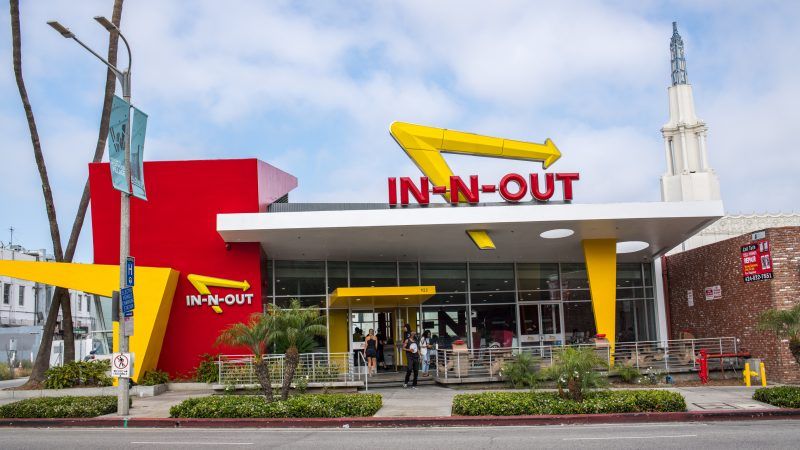California NIMBYs Sue To Stop In-N-Out Burger From Coming to Their Town
Opponents use a notorious environmental review law to keep a famed fast food restaurant out of Rancho Mirage.

Two of California's greatest passions are colliding: NIMBYism and In-N-Out Burger.
In September, the people of Rancho Mirage learned that the regional burger chain intended to establish a new location in the vacant corner of a shopping center in their southern California city. Given the almost cult-like acclaim In-N-Out has attracted in California and across the Southwest, many residents were thrilled at the news. In letters to the city council, some expressed excitement about the prospect of having another place to grab a quick lunch. Business owners in the shopping center were happy too, figuring that the big-name brand could bring more customers to their stores.
By the end of the month, the city's Planning Commission had voted to approve In-N-Out's Rancho Mirage location. In October the city council gave its assent as well.
But not everyone was thrilled at the prospects of In-N-Out setting up in the city. A group comprised mostly of homeowners near the proposed site objected to the added noise, traffic, and emissions that they feared the restaurant would bring.
They also objected to the way in which the authorities had approved the project. The city had rezoned In-N-Out's property to allow for a fast food restaurant and declared that the project qualified for an exemption from the California Environmental Quality Act (CEQA)—a state law that requires projects be studied for significant environmental impacts.
As the In-N-Out project worked its way through the planning process, these opponents—who'd organized themselves under the group Save Rancho Mirage—submitted critical comment letters to city officials, picketed the proposed site of the restaurant, and showed up at public hearings to demand the project be stopped.
"Last Spring, much of the country was shocked to learn that elite members of society ignored the rule of law and bought their way into prestigious colleges," one opponent wrote to the city council. "Watching the Rancho Planning Commission ignore the rule of law last month as it railroaded through a recommended zoning change, a conditional use permit for In-N-Out, and other related proposals was just as bad."
When these protests proved ineffective at stopping city approval of the project, Save Rancho Mirage filed a lawsuit. It argues that the city had violated CEQA and illegally rezoned the site. The very popularity of In-N-Out, they claim, all but assures there will be significant environmental impacts that need to be studied and addressed.
"The traffic, noise, gas-house emissions and otherwise overall environmental degradation of these restaurants on surrounding neighborhoods is known to the public at large and is storied," says the suit. "It is a love affair that the public has with this restaurant that also brings an unfathomable burden on a surrounding neighborhood."
Local ABC affiliate KESQ reports that In-N-Out has committed to traffic mitigation measures if congestion proves a problem. This hasn't been enough for the opponents, who are demanding that any activity on the In-N-Out project be stopped, that a full environmental impact report be performed, and that the city pay the plaintiffs' attorney fees.
Accusations that a project has failed to satisfy CEQA's requirements is a common tactic among anti-growth groups. The law has been invoked in order to homeless shelters, apartment complexes, hotels, and even single-family homes.
If the lawsuit succeeds, you can add In-N-Out to the roll call of CEQA's victims. And even if the legal action fails, they still have managed to cost In-N-Out—not to mention its future customers and employees—both time and money.
Rent Free is a weekly newsletter from Christian Britschgi on urbanism and the fight for less regulation, more housing, more property rights, and more freedom in America's cities.


Show Comments (62)